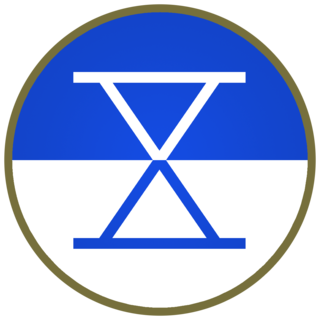
X Corps was a corps of the United States Army in World War II and the Korean War.

The 3rd Marine Division is an infantry division of the United States Marine Corps based at Camp Courtney, Marine Corps Base Camp Smedley D. Butler and Okinawa, Japan. It is one of three active duty divisions in the Marine Corps and together with the 1st Marine Aircraft Wing (1stMAW) and the 3rd Marine Logistics Group forms the III Marine Expeditionary Force. The division was first formed during World War II and saw four years of continuous combat in the Vietnam War.

The 4th Marine Division is a reserve division in the United States Marine Corps. It was raised in 1943 for service during World War II, and subsequently fought in the Pacific against the Japanese. Deactivated after the war, the division was re-formed in 1966 and elements of the division deployed during the Gulf War in 1990–1991. It is currently the ground combat element of the Marine Forces Reserve and is headquartered in New Orleans, Louisiana and has units throughout the United States.

Cactus Air Force refers to the ensemble of Allied air power assigned to the island of Guadalcanal from August 1942 until December 1942 during the early stages of the Guadalcanal Campaign, particularly those operating from Henderson Field. The term "Cactus" comes from the Allied code name for the island. In 1943 the Cactus Air Force was subsumed into (AirSols), a joint command of Allied air units in the Solomon Islands.

Marine Light Attack Helicopter Squadron 369 (HMLA-369) is a United States Marine Corps helicopter squadron consisting of AH-1Z Viper attack helicopters and UH-1Y Venom utility helicopters. The squadron, also known as the "Gunfighters", is based at Marine Corps Air Station Camp Pendleton, California and falls under the command of Marine Aircraft Group 39 (MAG-39) and the 3rd Marine Aircraft Wing.

Marine Heavy Helicopter Squadron 772 (HMH-772) is a United States Marine Corps helicopter squadron consisting of CH-53E Super Stallion transport helicopters. The squadron, known as "Hustler" or "the Hustlers", is based at McGuire AFB, New Jersey and falls under the command of Marine Aircraft Group 49 (MAG-49) and the 4th Marine Aircraft Wing.

Marine Aircraft Group 13 is a United States Marine Corps aviation unit based at Marine Corps Air Station Yuma that is currently composed of two McDonnell Douglas AV-8B Harrier II squadrons, two Lockheed Martin F-35B Lightning II squadrons, an unmanned aerial vehicle squadron, a maintenance and logistics squadron, and a wing support squadron. The group falls under the command of the 3rd Marine Aircraft Wing and the I Marine Expeditionary Force.

The Marine Corps League is the only Congressionally chartered United States Marine Corps-related veterans organization in the United States. Its Congressional Charter was approved by the 75th U.S. Congress and signed by President Franklin D. Roosevelt on August 4, 1937. The organization credits its founding in 1923 to legendary Marine Corps Commandant John A. Lejeune.

The 9th Marine Regiment was an infantry regiment of the United States Marine Corps. Formed during World War II, it served until 1994, when it was deactivated during the post Cold War drawdown. Battalions of the Ninth Marine Regiment, but not the regiment itself, were reactivated from 2007 to 2014 as part of the Marine Corps' growth during the wars in Iraq and Afghanistan. The battalions have subsequently been deactivated again.
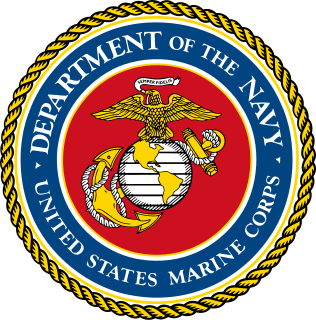
The United States Marine Corps is organized within the Department of the Navy, which is led by the Secretary of the Navy (SECNAV). The most senior Marine commissioned officer is the Commandant of the Marine Corps, responsible for organizing, recruiting, training, and equipping the Marine Corps so that it is ready for operation under the command of the unified combatant commanders. The Marine Corps is organized into four principal subdivisions: Headquarters Marine Corps, the Operating Forces, the Supporting Establishment, and the Marine Forces Reserve.
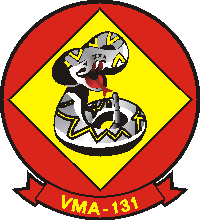
Marine Attack Squadron 131 (VMA-131) was an A-4 Skyhawk attack squadron in the United States Marine Corps. The squadron, also known as the “Diamondbacks”, were part of the Marine Forces Reserve and were based at Naval Air Station New York, Brooklyn, New York from 1960 through 1972 and NASJRB Willow Grove from 1972 until their deactivation in 1998.
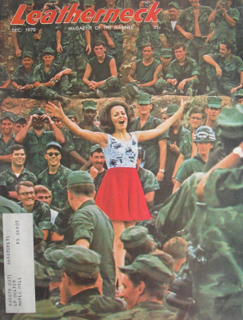
Leatherneck Magazine of the Marines is a magazine for United States Marines.

The 2nd Marine Expeditionary Brigade is a brigade of the United States Marine Corps. It is part of II Marine Expeditionary Force. It advertises itself as a "middleweight" crises response force of choice in the European and Southern Command Areas of Operation. It is able to "operate independently, as a service component, or to lead a Joint Task Force". Self-sufficient and interoperable, the 2nd Marine Expeditionary Brigade possesses a mix of command and control, combat power and specialized logistics. Operating as part of the greater Marine Corps team and with support from the United States Navy and other services, it can provide operational reach.

4th Civil Affairs Group is a civil affairs (CA) unit of the United States Marine Corps. It is based in Hialeah, FL. For information on 4th CAG prior to 2012, see 2D CAG, which was formed out of the original 4th CAG in Washington D.C. It is one of only four civil affairs groups in the Marine Corps, all of which are reserve units. 4th CAG was the first civil affairs group in the Marine Corps and mostly supports II MEF.
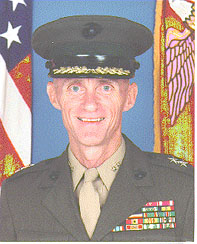
Leslie M. Palm is a retired United States Marine Corps major general who is currently the Publisher and CEO of the Marine Corps Association. His last active duty position was the Director, Marine Corps Staff, Headquarters Marine Corps, Washington, D.C. (1996–1998). Palm retired on September 1, 1998.

Richard C. Mangrum was a United States Marine Corps lieutenant general who served as Assistant Commandant of the Marine Corps from 1965 to 1967. Mangrum was a Marine Corps aviator who was awarded the Navy Cross and the Distinguished Flying Cross for his actions during the Guadalcanal Campaign in World War II.

9th Communication Battalion is a communications battalion in the United States Marine Corps. It is part of the I Marine Expeditionary Force and is headquartered at Marine Corps Base Camp Pendleton, California.

Camp Leatherneck is a 1,600 acre Afghan Armed Forces base in Helmand Province, Afghanistan. The site is mostly in Washir District and is conjoined with Camp Bastion, the main British military base in Afghanistan.

The United States Army Air Corps (USAAC) was the aerial warfare service of the United States of America between 1926 and 1941. After World War I, as early aviation became an increasingly important part of modern warfare, a philosophical rift developed between more traditional ground-based army personnel and those who felt that aircraft were being underutilized and that air operations were being stifled for political reasons unrelated to their effectiveness. The USAAC was renamed from the earlier United States Army Air Service on 2 July 1926, and was part of the larger United States Army. The Air Corps became the United States Army Air Forces (USAAF) on 20 June 1941, giving it greater autonomy from the Army's middle-level command structure. During World War II, although not an administrative echelon, the Air Corps (AC) remained as one of the combat arms of the Army until 1947, when it was legally abolished by legislation establishing the Department of the Air Force.

Joseph Orville Butcher was decorated officer of the United States Marine Corps who reached the rank of major general. He spent his career mostly in Quartermaster Department of the Marine Corps beginning in the field assignments during World War II. Butcher later served as commanding general, Marine Corps Supply Center Albany and also Assistant Quartermaster General of the Marine Corps and deputy to Major General Chester R. Allen.





















